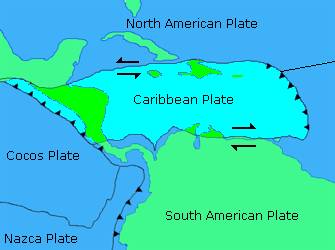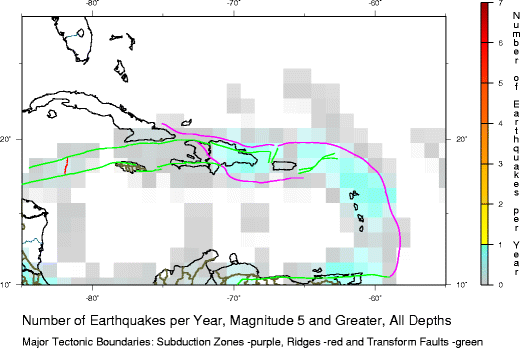 | Caribbean Plate |
|
|
Triple Junctions.Subduction-subduction-transform.The Cocos plate is subducted beneath the Montagua transform fault between the North American plate and the Caribbean plate |
|
From http://whatonearth.olehnielsen.dk/plates/caribbean.asp
The Caribbean Plate is a mostly oceanic tectonic plate underlying Central America and the Caribbean Sea off the north coast of South America.Roughly 3.2 million km2 in area, the Caribbean Plate borders the North American Plate, the South American Plate, and the Cocos Plate
The eastern and western margins are active subduction zones where oceanic lithosphere, belonging to the Atlantic Ocean in the east and to the Pacific Ocean in the west, subduct under the Caribbean Plate.
The Puerto Rico Trench is an oceanic trench located on the boundary between the Caribbean Sea and the Atlantic Ocean. The trench is associated with a complex transition between the subduction zone to the south along the Lesser Antilles island arc and the major transform fault zone or plate boundary that extends west between Cuba and Hispaniola through the Cayman Trench to the coast of Central America.
The Cocos Plate in the Pacific Ocean is subducted beneath the Caribbean Plate, just off the western coast of Central America at the Central American Trench. This subduction forms the volcanoes of Guatemala, El Salvador, Nicaragua, and Costa Rica. At the triple junction the boundary between the North American plate and the Caribbean plate is formed by the long Montagua transform fault.
The Cayman Trough, or Cayman Trench, also called Bartlett Deep, or Bartlett Trough, is a complex transform boundary which contains a small spreading ridge on the floor of the western Caribbean Sea between Jamaica and the Cayman Islands. During the Eocene the trough was the site of a subduction zone which formed the volcanic arc of the Cayman Ridge and the Sierra Maestra volcanic terrain of Cuba to the north as the northestward moving Caribbean Plate was subducted along the Cuban microplate.
The Caribbean Plate is thought to be a large igneous province that formed in the Pacific Ocean tens of millions of years ago. As the Atlantic ocean widened, North America and South America were pushed westward, and the Pacific Ocean floor began to subduct under the western edges of the American continents. The Caribbean Plate is thicker and lay higher than the rest of the Pacific Ocean floor, and instead overrode the Atlantic Ocean floor, moving eastward relative to North America and South America, and, with the formation of the Isthmus of Panama 2¢3 million years ago, ultimately losing its connection to the Pacific.



